RC-Effects on the Oxide of SOI MOSFET under Off-State TDDB Degradation: RF Characterization and Modeling
Abstract
:1. Introduction
2. Description of Devices and Experiments
2.1. Fabricated Devices and Test Fixture
2.2. Off-State Stress Experiments
2.3. S-Parameter Measurements
3. Enhanced Equivalent Circuit Modeling
3.1. Modeling of Loss Mechanisms on Input Impedance
3.2. Parameter Extraction Methodology
4. Results
5. Conclusions
Author Contributions
Funding
Data Availability Statement
Conflicts of Interest
References
- Verma, S.; Abdullah, M. Review of SOI MOSFET Design and Fabrication Parameters and its Electrical Characteristics. Int. J. Comput. Appl. 2015, 130, 1–7. [Google Scholar] [CrossRef]
- Aziz, M.N.I.A.; Salehuddin, F.; Zain, A.S.M.; Kaharudin, K.E.; Radzi, S.A. Comparison of Electrical Characteristics between Bulk MOSFET and Silicon-on-Insulator (SOI) MOSFET. J. Telecommun. Electron. Comput. Eng. JTEC 2014, 6, 45–49. [Google Scholar]
- Ashaf, A.; Tyagi, M.; Mani, P. To Study High Performance Analysis of Surround Gate SOI MOSFET. Int. J. Eng. Technol. 2018, 7, 191–194. [Google Scholar] [CrossRef]
- Affendi, K.; Mohd, R.; Mamun, M.; Arif, M. A Comparative Study on SOI MOSFETs for Low Power Applications. Res. J. Appl. Sci. Eng. Technol. 2013, 5, 2586–2591. [Google Scholar]
- Marshall, A.; Natarajan, S. PD SOI and FD SOI: A Comparison of Circuit Performance. In Proceedings of the 9th International Conference on Electronics, Circuits and Systems, Dubrovnik, Croatia, 15–18 September 2002. [Google Scholar]
- Ciocoveanu, R.; Weigel, R.; Hagelauer, A.; Geiselbrechtinger, A.; Issakov, V. 5G mm-Wave Stacked Class AB Power Amplifier in 45 nm PD-SOI CMOS. In Proceedings of the Asia-Pacific Microwave Conference (APMC), Kyoto, Japan, 6–9 November 2018. [Google Scholar]
- Ciocoveanu, R.; Lammert, V.; Weigel, R.; Issakov, V. An Integrated 28 GHz Front-End Module for 5G Applications in 45 nm PD-SOI. In Proceedings of the IEEE MTT-S International Microwave Conference on Hardware and Systems for 5G and Beyond (IMC-5G), Atlanta, GA, USA, 15–16 August 2019. [Google Scholar]
- Rathi, A.; Srinivasan, P.; Guarin, F.; Dixit, A. Investigation of Temperature Dependence of mmWave Power Amplifier Large-Signal Reliability Performance. IEEE Trans. Electron. Devices 2023, 70, 928–933. [Google Scholar] [CrossRef]
- Degraeve, R.; Kaczer, B.; De Keersgieter, A.; Groeseneken, G. Relation between Breakdown Mode and Location in Short-Channel nMOSFETs and its Impact on Reliability Specifications. IEEE Trans. Device Mater. Reliab. 2001, 1, 163–169. [Google Scholar] [CrossRef]
- Gao, T.; Yang, J.; Liu, H.; Lu, Y.; Liu, C. Experimental Study on Critical Parameters Degradation of Nano PDSOI MOSFET under TDDB Stress. Micromachines 2023, 14, 1504. [Google Scholar] [CrossRef]
- Kaczer, B.; De Keersgieter, A.; Mahmood, S.; Degraeve, R.; Groeseneken, G. Impact of Gate-Oxide Breakdown of Varying Hardness on Narrow and Wide nFET’s. In Proceedings of the IEEE International Reliability Physics Symposium, Phoenix, AZ, USA, 25–29 April 2004. [Google Scholar]
- Chen, T.W.; Ito, C.; Loh, W.; Dutton, R.W. Post-Breakdown Leakage Resistance and Its Dependence on Device Area. Microelectron. Reliab. 2006, 46, 1612–1616. [Google Scholar] [CrossRef]
- Miranda, E.; Kaguanago, T.; Kakushima, K.; Suñé, J.; Iwai, H. Modeling of the Output Characteristics of Advanced N-Mosfets after a Severe Gate-To-Channel Dielectric Breakdown. Microelectron. Eng. 2013, 109, 322–325. [Google Scholar] [CrossRef]
- Miranda, E.; Kawanago, T.; Kakushima, K.; Suñé, J.; Iwai, H. Analysis and Simulation of the Postbreakdown I−V Characteristics of n-MOS Transistors in the Linear Response Regime. IEEE Electron Device Lett. 2013, 34, 798–800. [Google Scholar] [CrossRef]
- Cattaneo, A.; Pinarello, S.; Mueller, J.-E.; Weigel, R. Impact of Dc and RF Non-Conducting Stress on Nmos Reliability. In Proceedings of the IEEE International Reliability Physics Symposium (IRPS), Monterey, CA, USA, 19–23 April 2015. [Google Scholar]
- Hofmann, K.; Holzhauser, S.; Kuo, C.Y. A Comprehensive Analysis of NFET Degradation due to off State Stress. In Proceedings of the IEEE International Integrated Reliability Workshop Final Report, South Lake Tahoe, CA, USA, 18–19 October 2004. [Google Scholar]
- Srinivasan, P.; Guarín, F.; Syed, S.; Jerome, J.A.S.; Liu, W. RF Reliability of SOI-based Power Amplifier FETs for mmWave 5G Applications. In Proceedings of the IEEE International Reliability Physics Symposium (IRPS), Monterey, CA, USA, 21–25 March 2021. [Google Scholar]
- Pazos, S.; Aguirre, F.; Palumbo, F.; Silveira, F. Reliability-Aware Design Space Exploration for Fully Integrated RF CMOS PA. IEEE Trans. Device Mater. Reliab. 2019, 20, 33–41. [Google Scholar] [CrossRef]
- Yang, H.; Yuan, J.S.; Liu, Y.; Xiao, E. Effect of Gate Oxide Breakdown on RF Performance. IEEE Trans. Device Mater. Reliab. 2003, 3, 93–97. [Google Scholar] [CrossRef]
- Li, X.; Qin, J.; Bernstein, J.B. Compact Modeling of MOSFET Wearout Mechanisms for Circuit Reliability Simulation. IEEE Trans. Device Mater. Reliab. 2008, 8, 98–121. [Google Scholar] [CrossRef]
- Dimitrov, V.; Heng, J.B.; Timp, K.; Dimauro, O.; Chan, R.; Hafez, M.; Feng, J.; Sorsch, T.; Mansfield, W.; Miner, J.; et al. Small-Signal Performance and Modeling of sub-50 Nm nMOSFETS with ft above 460-Ghz. Solid-State Electron. 2008, 52, 899–908. [Google Scholar] [CrossRef]
- Zárate, F.; García, D.; Vega, V.; Torres-Torres, R.; Murphy, R.S. Characterization of Hot-Carrier-Induced RF-MOSFET Degradation at Different Bulk Biasing Conditions from S-Parameters. IEEE Trans. Microw. Theory Tech. 2015, 64, 125–132. [Google Scholar] [CrossRef]
- Johansson, S.; Berg, M.; Persson, K.-M.; Lind, E. A High-Frequency Transconductance Method for Characterization of High-κ Border Traps in III-V MOSFETs. IEEE Trans. Electron. Devices 2012, 60, 776–781. [Google Scholar] [CrossRef]
- Chaparro, D.A.; Otero-Carrascal, A.Y.; Gutiérrez, E.A.; Torres-Torres, R.; Huerta, O.; Srinivasan, P.; Guarín, F. Impact of Non-Conducting HCI Degradation on Small-Signal Parameters in RF SOI MOSFET. In Proceedings of the IEEE International Reliability Physics Symposium (IRPS), Monterey, CA, USA, 26–30 March 2023. [Google Scholar]
- Zou, X.; Yang, J.; Qiao, Q.; Zou, X.; Chen, J.; Shi, Y.; Ren, K. Trap Characterization Techniques for GaN-Based HEMTs: A Critical Review. Micromachines 2023, 14, 2044. [Google Scholar] [CrossRef]
- Suñé, S.; Mura, G.; Miranda, E. Are Soft Breakdown and Hard Breakdown of Ultrathin Gate Oxides Actually Different Failure Mechanisms? IEEE Electron Device Lett. 2000, 21, 167–169. [Google Scholar] [CrossRef]
- Fang, J.; Sapatnekar, S.S. Scalable Methods for the Analysis and Optimization of Gate Oxide Breakdown. In Proceedings of the IEEE International Symposium on Quality Electronic Design (ISQED), San Jose, CA, USA, 22–24 March 2010. [Google Scholar]
- Li, C.; Wang, M.; Chi, T.; Kumar, A.; Boenke, M.; Wang, D.; Cahoon, N.; Bandyopadhyay, A.; Joseph, A.; Wang, H. 5G mm-Wave Front-End-Module Design with Advanced SOI Process. In Proceedings of the 2017 IEEE 12th International Conference on ASIC (ASICON), Guiyang, China, 25–28 October 2017; pp. 1017–1020. [Google Scholar]
- Lee, S.; Jagannathan, B.; Narasimha, S.; Chou, A.; Zamdmer, N.; Johnson, J.; Williams, R.; Wagner, L.; Kim, J.; Plouchart, J.O.; et al. Record RF performance of 45-nm SOI CMOS Technology. In Proceedings of the IEEE International Electron Devices Meeting, Washington, DC, USA, 10–12 December 2007; pp. 255–258. [Google Scholar]
- Naseh, S.; Deen, M.J.; Marinov, O. Effects of Hot-carrier stress on the RF Performance of 0.18/spl mu/m Technology NMOSFETs and Circuits. In Proceedings of the IEEE International Reliability Physics Symposium (IRPS), Dallas, TX, USA, 7–11 April 2002. [Google Scholar]
- Vandamme, E.P.; Schreurs, D.; Van Dinther, G. Improved Three-Step De-Embedding Method to Accurately Account for the Influence of Pad Parasitics in Silicon On-Wafer RF Test-Structures. IEEE Trans. Electron Devices 2001, 48, 737–742. [Google Scholar] [CrossRef]
- Torres-Torres, R.; Murphy, R.S.; Decoutere, S. MOSFET Gate Resistance Determination. Electron. Lett. 2003, 39, 248–250. [Google Scholar] [CrossRef]
- Torres-Torres, R.; Murphy, R.S.; Augendre, E.; Decoutere, S. Impact of Technology Scaling on the Input and Output Features of RF-MOSFETs: Effects and Modeling. In Proceedings of the 33rd Conference on European Solid-State Device Research, Estoril, Portugal, 16–18 September 2003. [Google Scholar]
- Van Langevelde, R.; Scholten, A.J.; Duffy, R.; Cubaynes, F.N.; Knitel, M.J.; Klaassen, D.B.M. Gate Current: Modeling, Delta L Extraction and Impact on RF Performance. In Proceedings of the International Electron Devices Meeting. Technical Digest, Washington, DC, USA, 2–5 December 2001. [Google Scholar]
- Yang, S.; Liu, K.; Xu, Y.; Liu, L.; Li, H.; Zhai, T. Gate Dielectrics Integration for 2D Electronics: Challenges, Advances, and Outlook. Adv. Mater. 2023, 35, 2207901. [Google Scholar] [CrossRef]
- Pozar, D.M. Microwave Engineering, 4th ed.; John Wiley & Sons, Inc.: Hoboken, NJ, USA, 2012. [Google Scholar]
- Huang, S.; Wang, X.; Liu, X.; Zhao, R.; Shi, W.; Zhang, Y.; Fan, J.; Yin, H.; Wei, K.; Zheng, Y.; et al. Capture and Emission Mechanisms of Defect States at Interface Between Nitride Semiconductor and Gate Oxides in Gan-Based Metal-Oxide-Semiconductor Power Transistors. J. Appl. Phys. 2019, 126, 164505. [Google Scholar] [CrossRef]
- Nicollian, E.H.; Goetzberger, A. The Si-SiO, Interface—Electrical Properties as Determined by the Metal-Insulator-Silicon Conductance Technique. Bell Syst. Tech. J. 1967, 46, 1033–1055. [Google Scholar] [CrossRef]
- Freedsman, J.J.; Kubo, T.; Egawa, T. Trap Characterization of In-Situ Metal-Organic Chemical Vapor Deposition Grown AlN/AlGaN/GaN Metal-Insulator-Semiconductor Heterostructures by Frequency-Dependent Conductance Technique. Appl. Phys. Lett. 2011, 99, 033504. [Google Scholar] [CrossRef]
- Ma, X.H.; Chen, W.W.; Hou, B.; Zhang, K.; Zhu, J.J.; Zhang, J.C.; Zheng, X.F.; Hao, Y. Investigation of Trap States Under Schottky Contact in GaN/AlGaN/AlN/GaN High Electron Mobility Transistors. Appl. Phys. Lett. 2014, 104, 093504. [Google Scholar] [CrossRef]
- Zhang, H.; Cui, Q.; Xu Yan, X.; Shi, J.; Lin, F. A 0.5–3.0 GHz SP4T RF Switch with Improved Body Self-biasing Technique in 130-nm SOI CMOS. J. Semicond. 2020, 41, 102404. [Google Scholar] [CrossRef]
- Egin, A.E.; Tambawala, A.; Swaminathan, M.; Bhattacharya, S.; Pramanik, P.; Yamazaki, K. Dielectric Constant and Loss Tangent Characterization of Thin High-K Dielectrics Using Corner-to-Corner Plane Probing. In Proceedings of the IEEE Electrical Performance of Electronic Packaging, Scottsdale, AZ, USA, 23 October 2006. [Google Scholar]
- Wang, S.C.; Su, P.; Chen, K.M.; Lin, C.T.; Liang, V.; Huang, G.H. On the RF Extrinsic Resistance Extraction for Partially-Depleted SOI MOSFETs. IEEE Microw. Wirel. Compon. Lett. 2007, 17, 364–366. [Google Scholar] [CrossRef]
- Ravariu, C. Gate Swing Improving for the Nothing on Insulator Transistor in Weak Tunneling. IEEE Trans. Nanotechnol. 2017, 16, 1115–1121. [Google Scholar] [CrossRef]

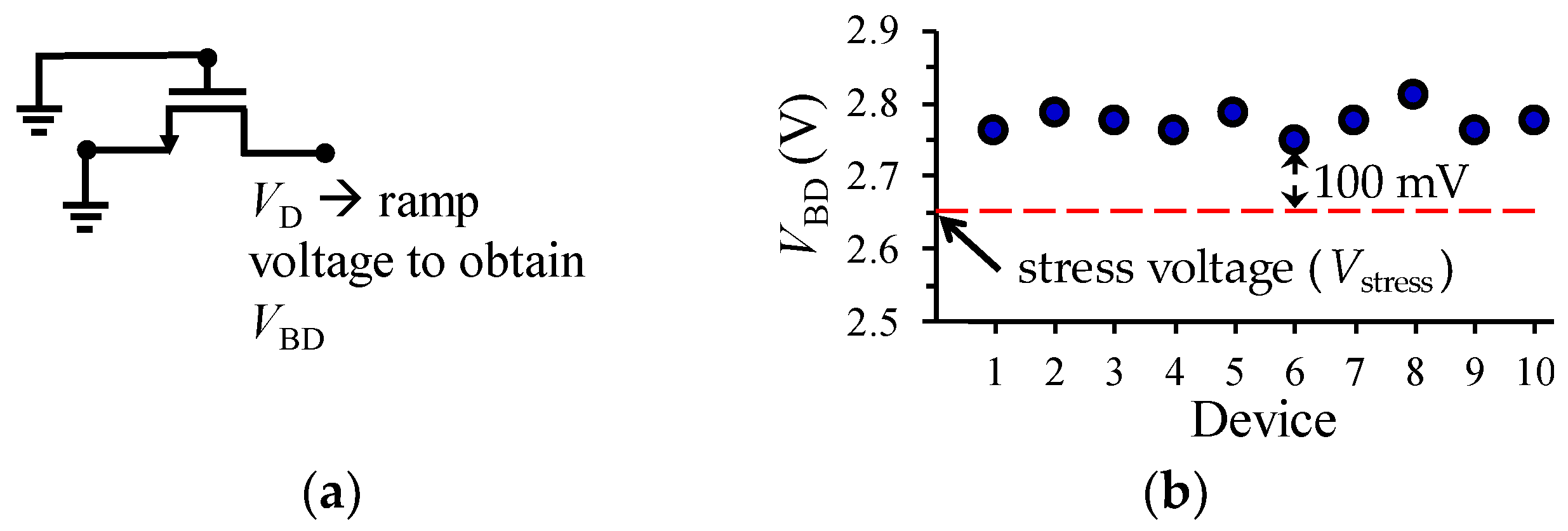

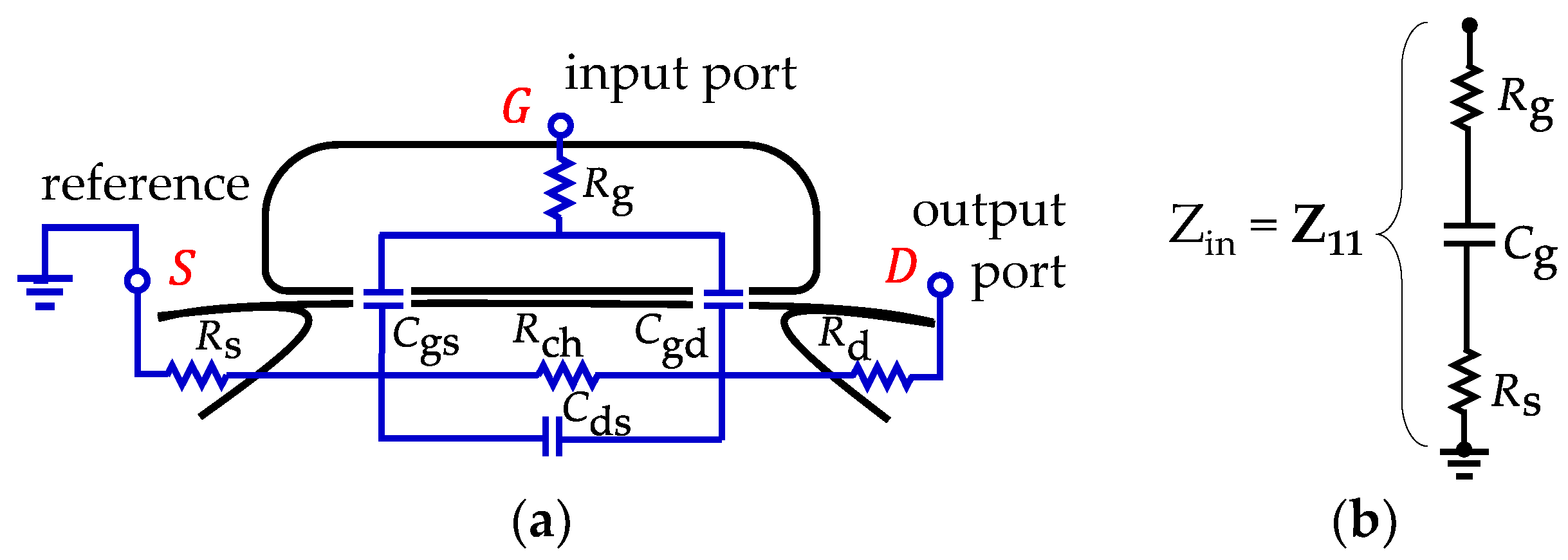
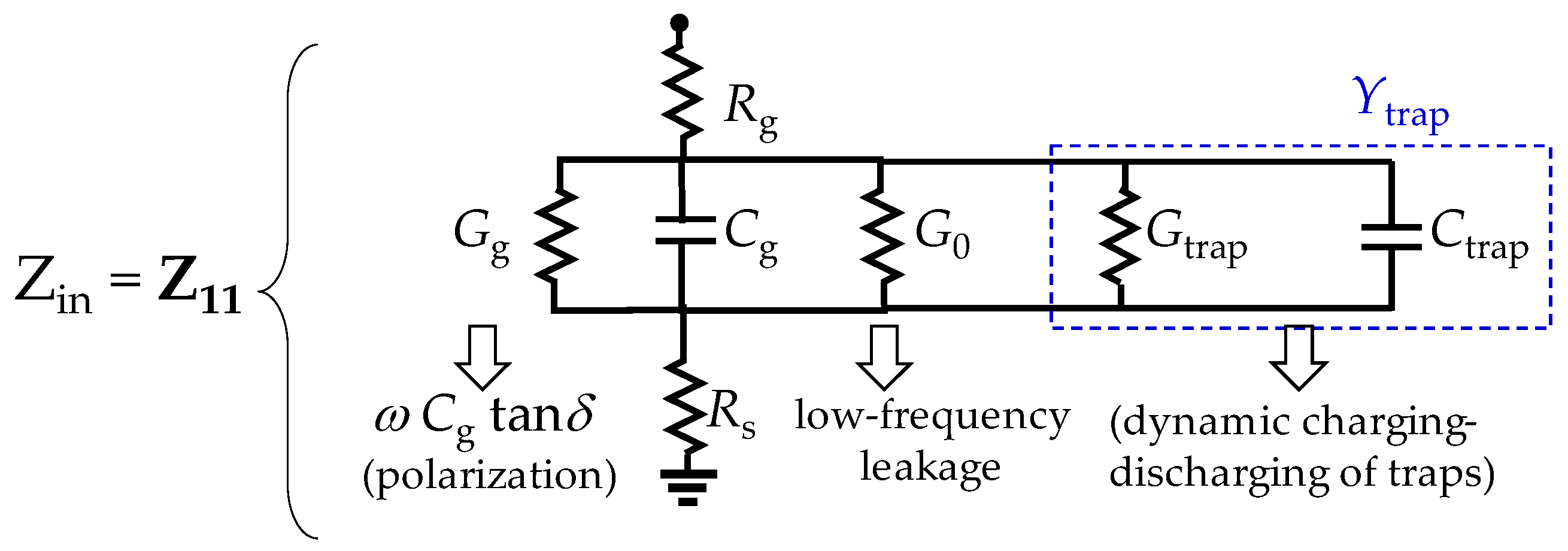
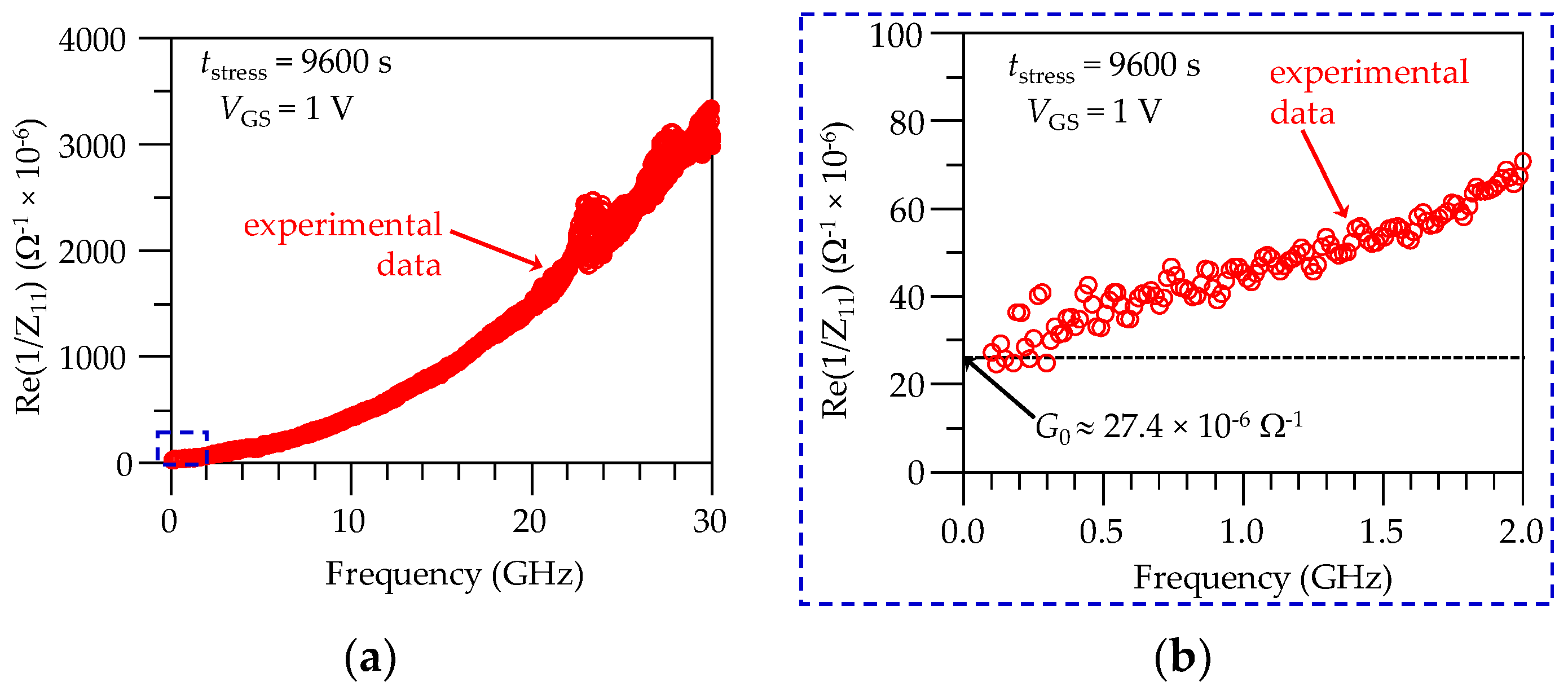

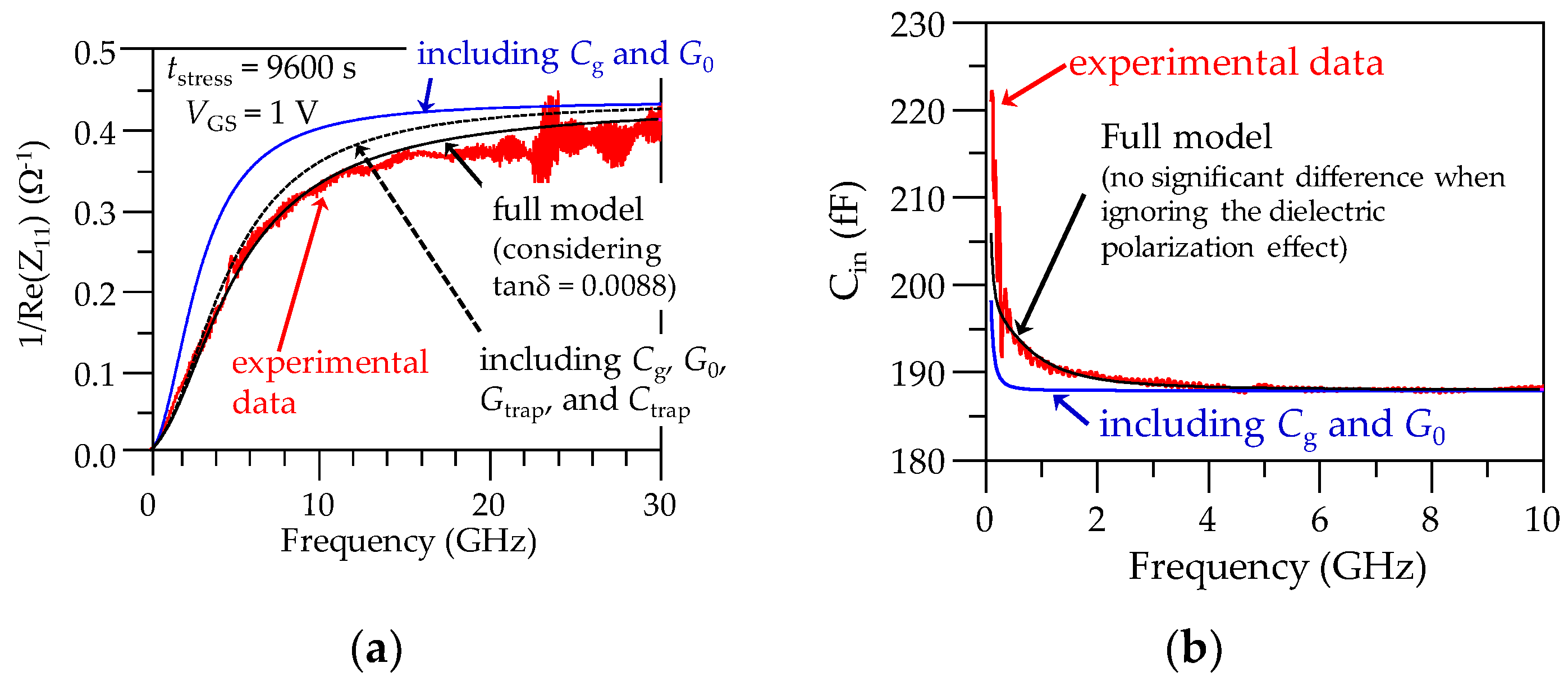

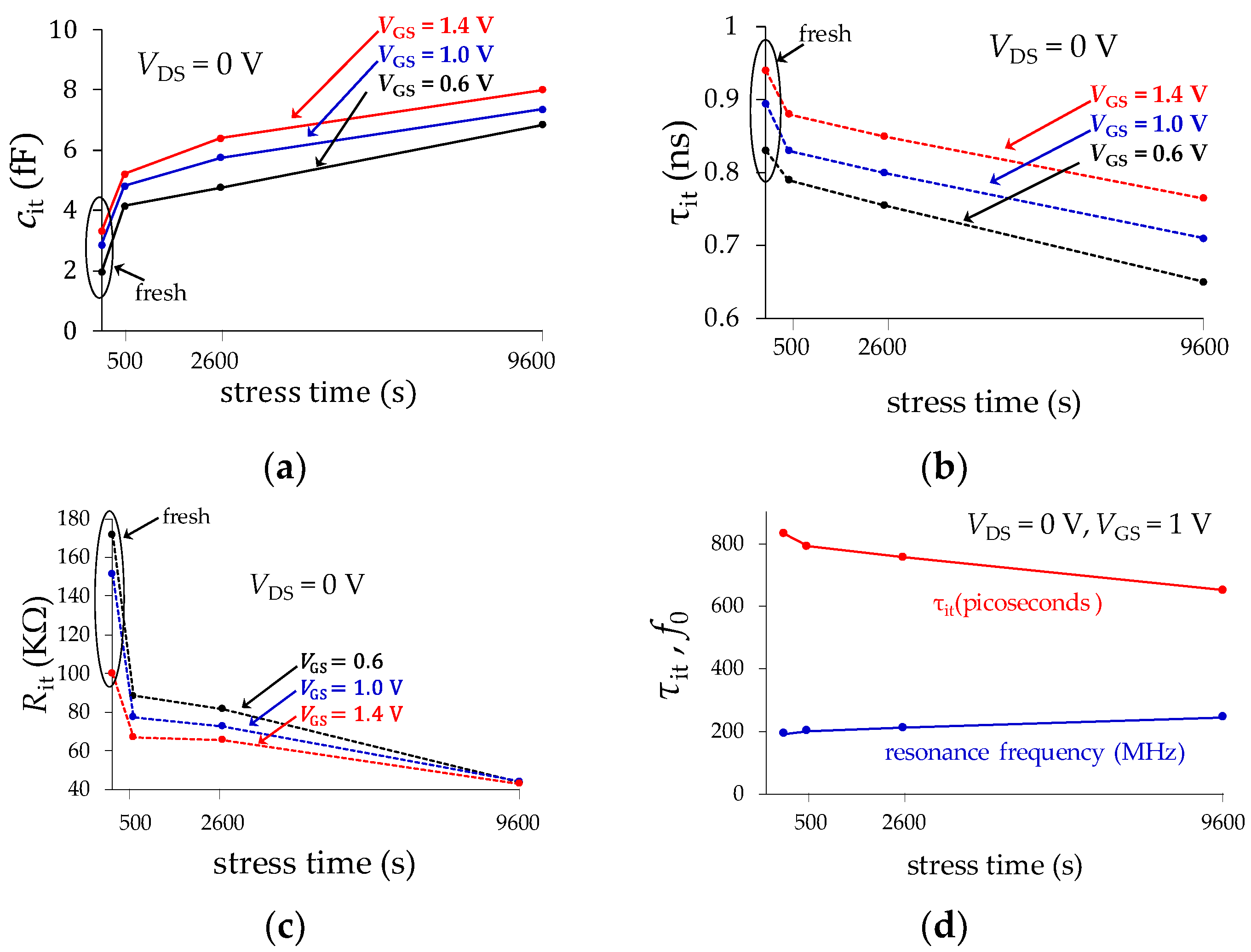
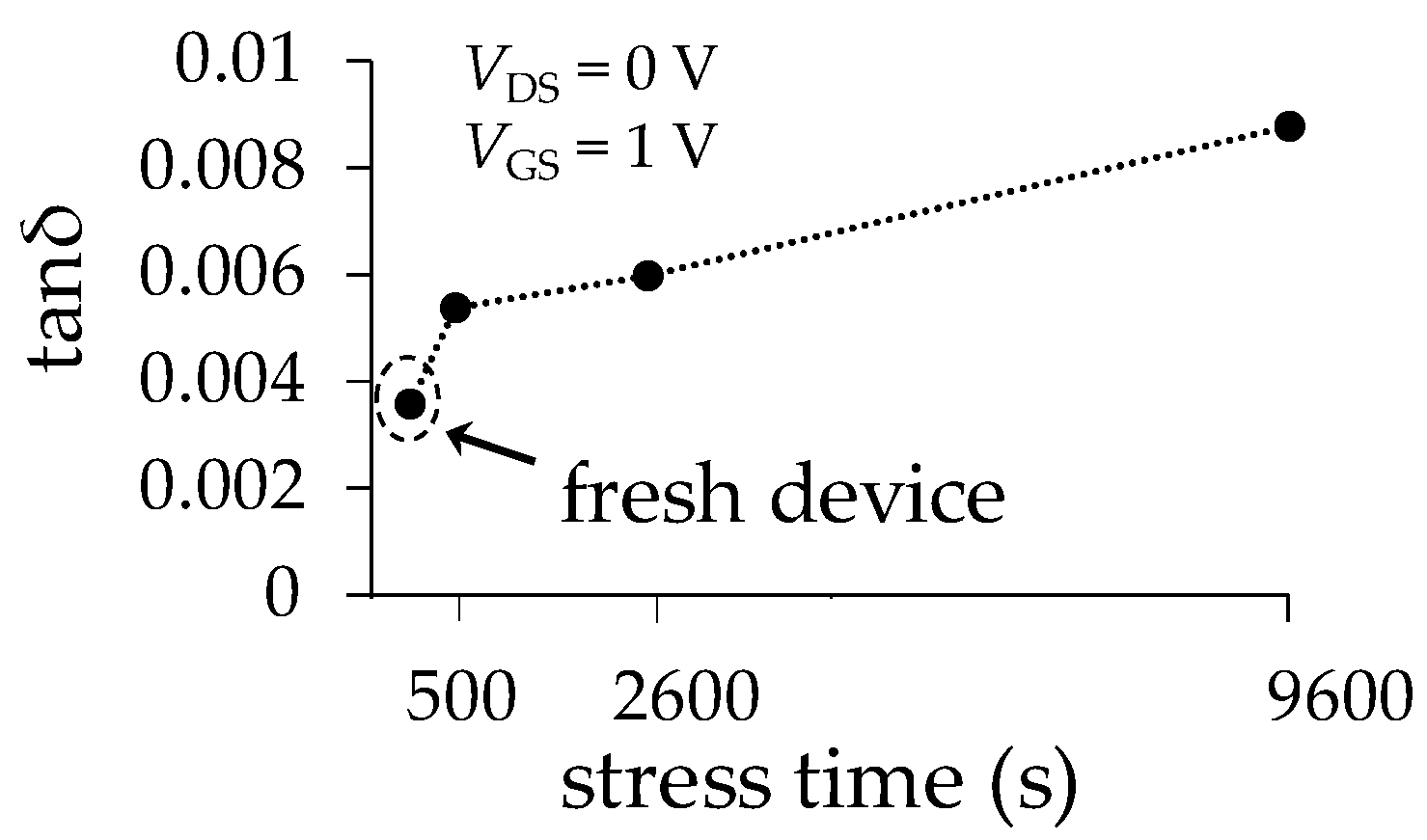
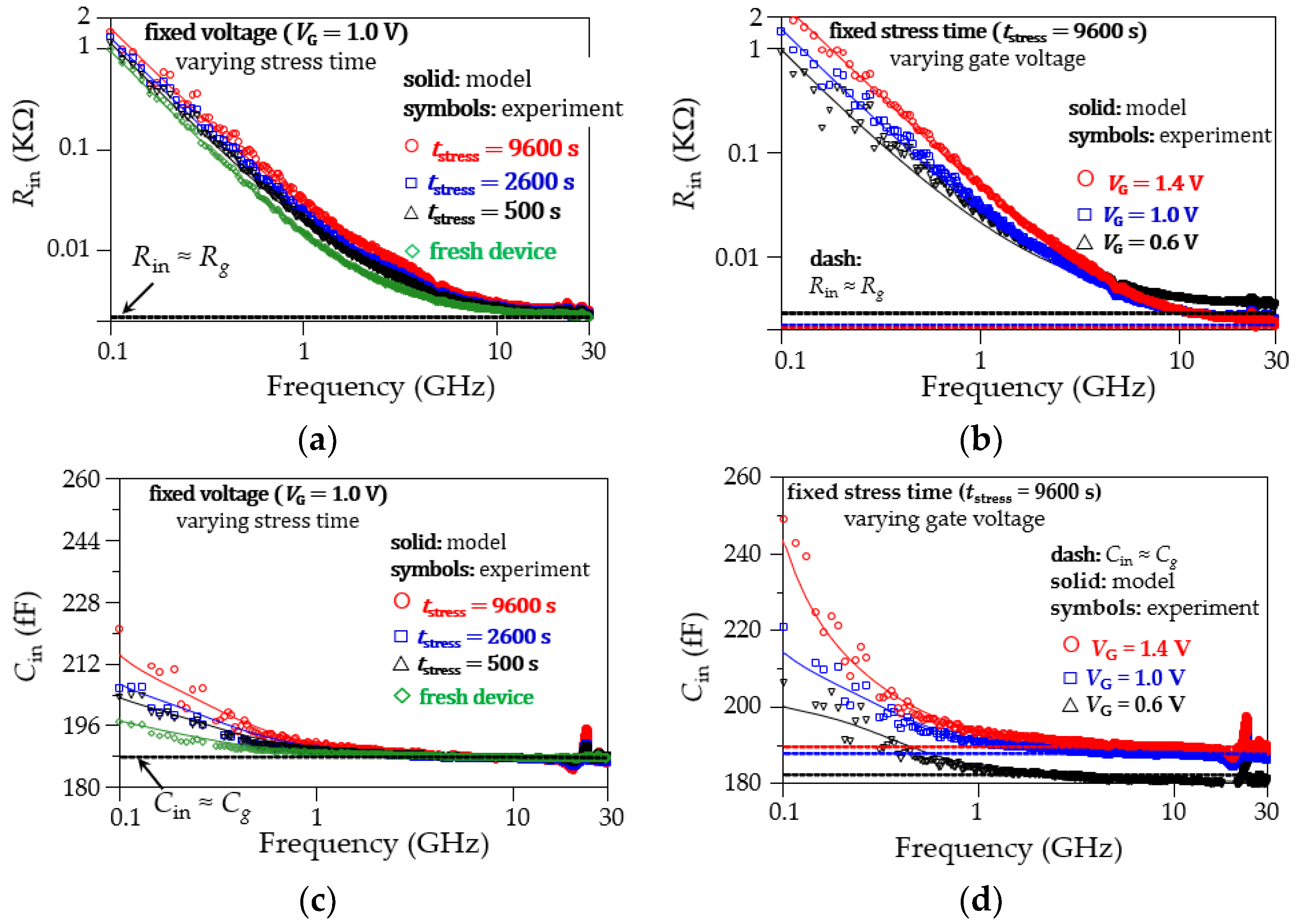
Disclaimer/Publisher’s Note: The statements, opinions and data contained in all publications are solely those of the individual author(s) and contributor(s) and not of MDPI and/or the editor(s). MDPI and/or the editor(s) disclaim responsibility for any injury to people or property resulting from any ideas, methods, instructions or products referred to in the content. |
© 2024 by the authors. Licensee MDPI, Basel, Switzerland. This article is an open access article distributed under the terms and conditions of the Creative Commons Attribution (CC BY) license (https://creativecommons.org/licenses/by/4.0/).
Share and Cite
Otero-Carrascal, A.; Chaparro-Ortiz, D.; Srinivasan, P.; Huerta, O.; Gutiérrez-Domínguez, E.; Torres-Torres, R. RC-Effects on the Oxide of SOI MOSFET under Off-State TDDB Degradation: RF Characterization and Modeling. Micromachines 2024, 15, 252. https://doi.org/10.3390/mi15020252
Otero-Carrascal A, Chaparro-Ortiz D, Srinivasan P, Huerta O, Gutiérrez-Domínguez E, Torres-Torres R. RC-Effects on the Oxide of SOI MOSFET under Off-State TDDB Degradation: RF Characterization and Modeling. Micromachines. 2024; 15(2):252. https://doi.org/10.3390/mi15020252
Chicago/Turabian StyleOtero-Carrascal, Alan, Dora Chaparro-Ortiz, Purushothaman Srinivasan, Oscar Huerta, Edmundo Gutiérrez-Domínguez, and Reydezel Torres-Torres. 2024. "RC-Effects on the Oxide of SOI MOSFET under Off-State TDDB Degradation: RF Characterization and Modeling" Micromachines 15, no. 2: 252. https://doi.org/10.3390/mi15020252






